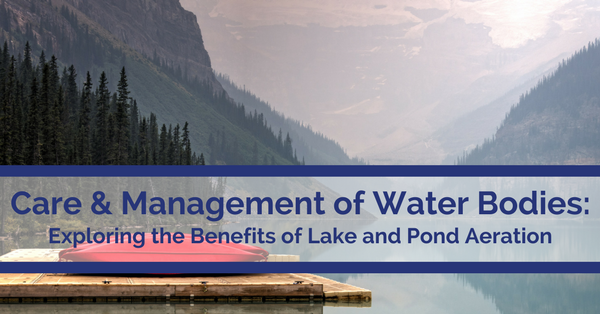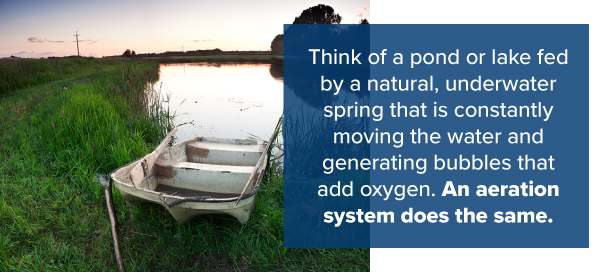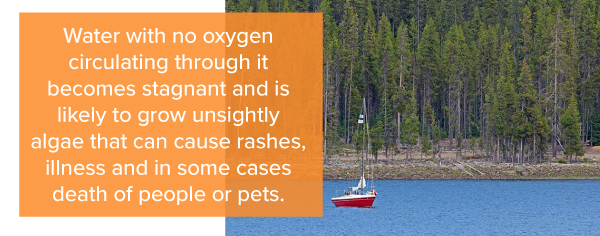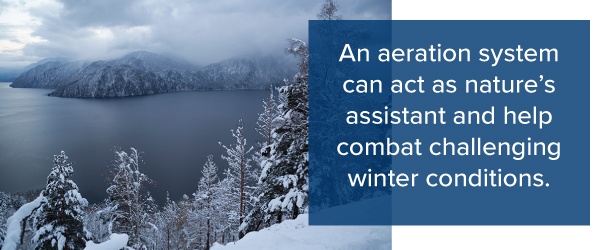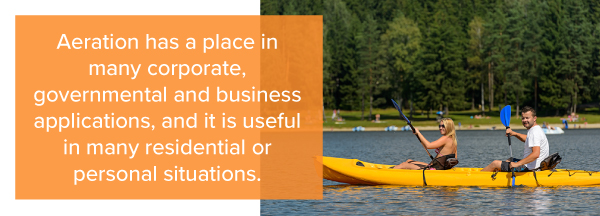Benefits of Lake & Pond Aeration
Effective aeration consists of circulating oxygen throughout a water body to prevent unhealthy conditions. Aerating ponds through out the year can be important for water bodies that have a history of low dissolved oxygen levels. Constant lake aeration will also help to prevent muck, odor and mosquitos, while also helping to improve water quality, and fish habitat.
Aeration will occur naturally, but often needs help to maintain optimum levels. Preventative care of your ponds and lakes through aeration keeps your ponds and lakes from becoming stagnant and cover with algae and muck, preventing the need for greater measures and investment to return your bodies of water to their natural healthy states.
What Is Aeration?
Think of a pond or lake fed by a natural, underwater spring that is constantly moving the water and generating bubbles that add oxygen. An aeration system does the same.
The word aeration means “to supply or impregnate with air,” according to Webster’s dictionary. During aeration of ponds and lakes, typically some kind of motorized mechanism creates compressed air and sends it to an underwater diffuser that releases it into the water. The air creates circulation by lifting bottom water to the surface where it can release noxious gases and pick up oxygen from the atmosphere.
Aeration can also occur at the surface of the water, usually in the form of a fountain or spraying device. The setups usually involve an impeller to force surface water and air upward so that water shoots into the air and lands on the surface to generate the oxygen transfer.
Oxygen in its dissolved form may be the single-most important aspect of water quality that pond and lake managers should understand and monitor.
Sources of dissolved oxygen are the atmosphere, plants in the water, algae and microscopic algae called phytoplankton. Plants and algae photosynthesize and add oxygen to the water during the daytime and will reverse the process during the night.
It is possible and even advisable to have more than one aeration solution in place, such as a floating and submersible system that work together for better results. Regular management and maintenance of your pond or lake should include multiple techniques to keep the water healthy.
The history of aeration in lakes and ponds dates to the 1950s when it was used as a tool to combat fish kills during winter. It did not take long for people to realize the advantages of winter lake aeration, as well as aeration in general.
What Are the Benefits of Lake and Pond Aeration?
Diffused aeration is the process of creating a vertical current in a water body with a column of air bubbles that eliminates stratification and moves oxygen to the bottom. There is a demand on the oxygen present in a waterbody due to biological processes that are occurring. Oxygen is quickly depleted at the bottom of a eutrophic or nutrient rich water body. Oxygen is absorbed at the surface, but fails to reach the bottom due to thermal stratification and lack of circulation.
Stratification occurring during the warmer months when colder, more dense water remains at the bottom of a water body while the warmer water is on the top. There is a physical barrier between these layers due to the thermal difference and the layers do not mix. A shallow pond or lake may not stratify because of the depth. Also during the winter months, water temperatures are more uniform top to bottom eliminating stratification as well.
The oxygen demand is not as great during the winter months, but diffused aeration will still ensure that oxygen is present in the deeper water and toxic gases such as carbon dioxide, hydrogen sulfide and ammonia will be vented off. Vegetation under thick ice can reduce oxygen levels to dangerous levels during the winter. Diffused aeration will keep open holes in the ice to prevent this from occurring as well.
Fountain surface aeration is a localized circulation system and is recommended for shallow lakes or ponds. Subsurface aeration is the best system for large, deep bodies of water. Using a high-quality system that is the correct type and size will keep the water clean and clear, the fish healthy and the vegetation in balance.
Why You Need Aeration
Some of the benefits of aeration are:
- Improved Water Quality – Fountains will help maintain higher oxygen levels and diffused aeration will help get oxygen to the deep water and prevent the buildup of toxic gases.
- Less Odor – Higher oxygen levels help the aerobic bacteria break down organic material in a water body. In the presence of oxygen, these bacteria are more efficient and beneficial to the health of your lake or pond.
- Reduced Nutrient Load – Aeration helps maintain the delicate balance of a healthy ecosystem in a pond or lake. When valuable oxygen is maintained at higher levels, nutrients will be broken down and used up which helps prevent possible algae mats and blooms.
- Better Fish Habitat – Diffused aeration prevents stratification to maintain an oxygen healthy habitat for fish and aquatic organisms they feed on. Using aeration to prevent ice from forming will prevent fish kills that can occur under the ice due to low oxygen levels in the winter months.
- Mosquito Control – Stagnant water is a breeding ground for mosquitos. A floating fountain or the diffused system naturally disrupts the breeding habitat necessary for mosquitos. With the risk of West Nile Virus and the other diseases mosquitos carry and transmit to people livestock and pets, aeration is as much a health concern as it is an environmental concern.
- Less Muck – Aeration may help prevent the necessity for dredging your pond or lake in the future by limiting the accumulation of debris and sediment that causes a layer of “muck.” By promoting the natural decomposition of organic matter with oxygen-rich conditions, the ecosystem at the bottom of your pond or lake will stay more balanced.
Whether you choose the visual esthetics of a fountain or a subsurface aeration system, the straightforward solution to keep a beautiful pond or lake is aeration.
Keep reading for additional inspiration and a wealth of information about our pond and lake services. Then, when you’re ready, take the next important step and contact us for a consultation. Find out today how we can make your lake or pond beautiful and healthy — and keep it that way.
What Happens Without Aeration?
Dissolved nutrients, such as phosphates, can flow into water and over-enrich it to the point that stimulates the disproportionate growth of unwanted aquatic plants such as harmful blue-green algae. The undesirable growth can then consume oxygen and rob fish and beneficial plants of what they need as well as produce toxins. The scientific term for the process is eutrophication.
Water with no oxygen circulating through it becomes stagnant and is likely to grow unsightly algae that can cause rashes, illness and in some cases death of people or pets from dangers such as cyanobacteria. In addition, standing water gives mosquitoes the perfect breeding habitat.
The normally helpful phytoplankton can grow excessively and have a negative effect by consuming too much oxygen. Also, if an algal bloom dies off, the oxygen level will rapidly drop and may cause a fish kill. Water where the healthy algae has died off suddenly may appear as if it has gray or brown streaks on the surface.
Low-oxygen conditions undoubtedly kill fish, which also need air to live. Fish kills can range in severity. Possibly just losing a portion of the population or eliminating an entire fish population. Generally, fish cannot survive in water where dissolved oxygen levels fall below 1 milligram of oxygen per liter.
Shallow water bodies are especially susceptible to lower oxygen simply because there is less water in which the oxygen can be stored. Poor circulation in water can also lead to warmer temperatures which may not support native fish or aquatic life. For example, trout need cooler water to survive and if they can not find the right conditions they will die.
Oxygen must circulate throughout the water, including the top and bottom of the lake or pond. Anything that inhibits movement also threatens the health of the water body. If a pond or lake has poor circulation, water that enters at the surface cannot make it down to organisms on or near the bottom.
This phenomenon, called stratification, happens in summer when the upper layer of the water is warm while the bottom layer remains cold. The difference in density prevents the layers from mixing which leads to the bottom water becoming depleted of oxygen.
Aerating ponds in the winter as well as all seasons can prevent a number of different problems. Stratification of a water body can impede the water’s ability to purify itself. Other factors that can have a negative impact on water quality include:
- Lawn Fertilizers and treatments containing phosphates
- Farm animals walking or watering in the body
- Fallen trees
- Beaver dams
- Sediment accumulation
- PH imbalance
- Contamination
- Erosion
- Septic seepage or leakage
- Excessive animal waste
Noxious algae blooms can cause sickness, dead pets and massive fish kills, as well as bad smells. In addition to the ecological value they provide, a water body can provide an economic benefit.
A tourist lake or recreation area tied to water with insufficient oxygen could contain dead fish, foul smells or other unpleasant aspects — a turnoff to visitors. Many healthy and abundant waters exist with diverse aquatic life, but others are in peril and could benefit from higher awareness and intervention techniques.
How can you tell if the water is aerated enough? How do you know if it contains enough oxygen? If conditions are bad, you will likely see dead fish and excessive algae blooms.
Minus any visible evidence that your water body has a low level of oxygen, you can conduct water testing to be sure oxygen remains at a safe level.
Why Should Aeration Continue Throughout Winter?
We tend to think of water bodies as inactive during winter, but they’re teeming with life under the surface at all times and remain active throughout the cold months. There are many benefits of aerating ponds in the winter.
Ice floats on the surface and blocks the main pathway for oxygen. Water becomes denser as it cools, making it harder for oxygen to circulate.
The water becomes cooler and denser in winter because of low temperatures and solar heating in water bodies decreases in winter. The sun stays out for fewer hours and its heat is less intense than in summer months. Snow on top of the ice also blocks the sun’s rays and can contribute to tough underwater conditions such as low oxygen.
Underwater plants need solar exposure to undergo the photosynthesis process that produces and releases vital dissolved oxygen in water. Less sun and colder, denser water during winter, along with ice and snow can all lead to lower oxygen levels.
An aeration system can act as nature’s assistant and help combat challenging winter conditions. Toxic gases can build up underwater and need open water to escape. If they cannot, the bad gases can accumulate and contribute to the poor health of a lake or pond.
Most lakes, ponds and rivers do not freeze solid during winter, even in sub-freezing temperatures. While the air temperature may vary, underwater temperatures remain relatively constant.
Aeration systems in a pond or lake will usually not keep the entire water body ice free. They will maintain a sizable hole in the ice where fish can take refuge and allows oxygen and sunlight to enter and gases to escape.
People, fish and plants need oxygen throughout the winter. Waterfowl and wildlife need a bit of open water for their survival as well. Waterfowl need a place to rest where predators cannot reach them, and some land animals need access to drinking water because their usual sources can ice over in the winter.
What Are My Aerator Options?
You have an array of options for aerating your water body, and the science of aeration has advanced to include choices that remain above the water, go beneath the water surface or include a combination of both. Beautifully patterned, impeller-powered fountains are a form of aeration. A common and efficient choice in aerators is a subsurface diffuser system, which can move a large volume of water per minute. Many applications or situations might call for more than one solution. Luckily you have many options, most of which can be customized.
How Can an Expert Consultant Help?
AEC Lakes offers a broad range of solutions for aerating ponds, lakes and other areas, as well as for the broader task of water management. The name Aquatic Environment Consultants was developed because we consultant on aquatic environments. We started building expertise, experience and a commitment to service and quality in 1987.
Our success results from the effective solutions we provide to customers. We are dedicated to customer satisfaction, answering questions, providing information and supplying the needed materials and equipment. We have been in business for decades, emerging as an industry leader with a commitment to quality and service. We’re also dedicated to the broader task of the research and development that enables continual refinement and improvement.
Don’t hesitate to contact us and discuss your needs for aeration as well as algae control, diffuser systems, fountains, fish stocking and management, vegetation and invasive-species management, annual maintenance, water-quality testing and restoration, mapping, monitoring, and system maintenance and repairs. Whatever your water-management needs may be, AEC Lakes can help.

